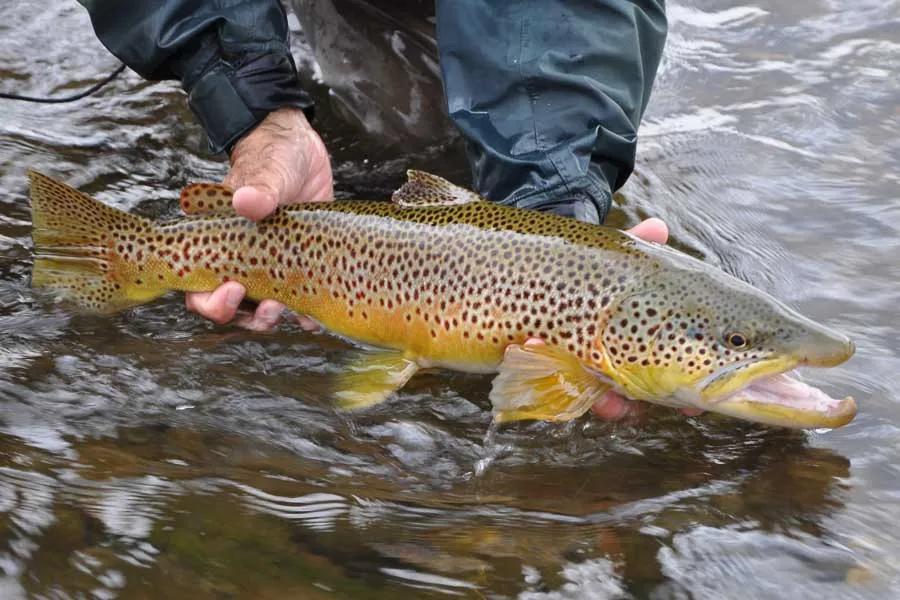
By John Herzer
Timeless cliff walls and ponderosa pines tower over deep, clear runs and boulder strewn riffles -- the Big Blackfoot is trout water. Affording both wading and floating angler opportunity for nearly sixty miles, the Big Blackfoot River is as diverse as the Montana landscape it shapes. Harboring good populations of Montana's only two "native" salmonids, cutthroats and bull trout, the Big Blackfoot is also abundant with rainbow, cutbows, browns and mountain whitefish throughout its length.
The Big Blackfoot's optimum fishing starts at River Junction Campground, at its confluence with the North Fork, just south of Ovando. Although initially rumbling past rolling ranch land, the river soon takes on its' more characteristic bank side vegetation, winding around canyon walls and house size boulders only ending at its confluence with the Clark Fork River five miles east of Missoula. All but the final ten miles of the Big Blackfoot are tucked away from busy roadways and housing developments, astonishing seclusion in light of its proximity to Montana's third largest population center.
Over looking a few local "I-flyfish-every-week-of-the-year-and-in-any temperature" hard cores, the Big Blackfoot action starts picking up around the middle of March. Anglers dredging nymphs and steamers realize surprising catches on into May and the onset of runoff. The much anticipated salmon fly hatch usually kicks off when the river is swollen and colored in early to mid June and bank fishing quickly becomes all but impossible. As the water starts to subside, savvy boat antlers able to mirror bushy dry flies and weighted streamers with the bank are rewarded with the Big Blackfoot's trophy browns ranging from 18" - 24".
With the dropping and clearing water of July comes a number of lesser stone fly, caddis, and a few may fly hatches -- together with more obvious holding areas. Dead drifting most any classic western attractor of moderate size motivates strikes from eager 10" - 16" rainbows and cutthroats. Use similar patterns (with the noted additions of hoppers with beadhead nymph droppers and uncertain cyclical hatches of spruce moths) on through August for similar action. By virtue of the Big Blackfoot's rapid speed, pool drop configuration and powerful size (even at low flows), its fish are rarely "selective" as compared to those of the Clark Fork or the Bitterroot. They have to eat the bugs passing over them right now or get very skinny waiting for easier targets.
The Big Blackfoot browns start to show themselves again in September and October as the aggression of their upcoming spawning run becomes apparent. The river is gin clear and at minimum flow as significant hatches rebound, including the giant orange sedge (October caddis). Days shorten, morning frosts the boats, elk bugles echo down to rivers edge, as mountain mahogany turns brilliant shades of red and yellow. Autumn is a great time to fly fish the Big Blackfoot.
Thanks to an unprecedented cooperative effort between public and private interests and more stringent fishing regulations, the Big Blackfoot River is quickly returning to the quality fishery that inspired Norman McLean's novel A River Runs Through It, and Robert Redford's subsequent big screen hit. Scarcely seven years ago only sun soaked tubers and an occasional bait fisherman utilized the Big Blackfoot. Today Highway 200 hums with numerous, eager guide rigs wheeling up river from Missoula with boats in tow.
Unfortunately, the Big Blackfoot's future isn't as clear as its waters. Just when it appears that people understand a river of such splendor is an important resource, planning begins for one of North American's largest cyanide heap leach gold mines at its headwaters! More information on how you can help continue trout fishing on this spectacular river is available at the address below.
Fly Box for the Big Blackfoot: Here is the very minimum selection anglers should carry with them when fishing the "Foot".
Dries: Wulffs and humpies (#14-10); parachute adams (#16-12); Goddard's and elk hair caddis (#14-8); stimulators; madam-x and parachute hoppers (#12-6)
Nymphs: prince, hare's ear, zug bug and pheasant tail all of which work better with beadheads in #16-12; golden and black stones (#10-4)
Streamers: olive, brown and black woolly buggers (#8-4); olive and black zonkers (#8-4)
WORDS OF CAUTION TO FLOATERS AND WADE FISHERS: The Big Blackfoot is a powerful, challenging river at any level. Float fishing is undoubtedly the most efficient means of angling, but not just any oars person should attempt this challenge. While high water covers many obstacles, it, in turn, exponentially increases force and reduces reaction time. Although low flow slows the pace a great deal, the exposed boulder fields require expert boat handling to negotiate rapids. Wading during run off is not recommended as the river is bank full, often up into willows and shrubs, and the visibility is poor. During low summer flows bank angling can be a delight for sure footed individuals. Felt soled boots are recommended; careful wading is required while traversing the varying river bottom. When booking an outfitter to float fish the Big Blackfoot, be assured their guides have not only experience on this section but that they also have experience under similar conditions for that particular time of year.
About the author: After pushing oars for the over twenty years across the American West and in Zimbabwe, Africa, John Herzer still spends over 100 days a year on the water. He and his wife, Terri Raugland, own and operate John Herzer's Blackfoot River Outfitters Inc. 610 Speedway, Missoula, Montana. E-mail address trout [at] mssl.uswest.net




